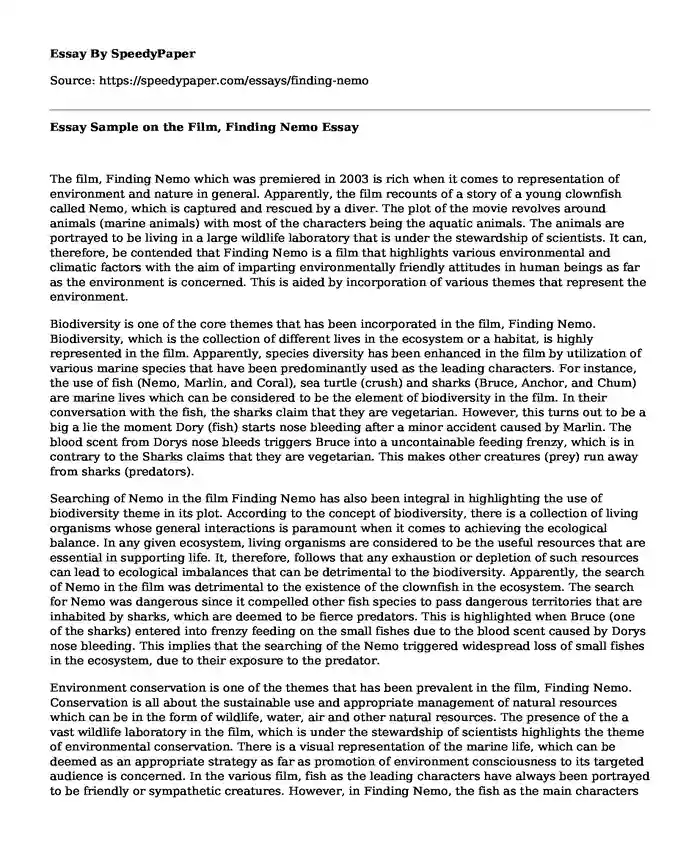
| Type of paper: | Essay |
| Categories: | Environment Movie |
| Pages: | 4 |
| Wordcount: | 861 words |
The film, Finding Nemo which was premiered in 2003 is rich when it comes to representation of environment and nature in general. Apparently, the film recounts of a story of a young clownfish called Nemo, which is captured and rescued by a diver. The plot of the movie revolves around animals (marine animals) with most of the characters being the aquatic animals. The animals are portrayed to be living in a large wildlife laboratory that is under the stewardship of scientists. It can, therefore, be contended that Finding Nemo is a film that highlights various environmental and climatic factors with the aim of imparting environmentally friendly attitudes in human beings as far as the environment is concerned. This is aided by incorporation of various themes that represent the environment.
Biodiversity is one of the core themes that has been incorporated in the film, Finding Nemo. Biodiversity, which is the collection of different lives in the ecosystem or a habitat, is highly represented in the film. Apparently, species diversity has been enhanced in the film by utilization of various marine species that have been predominantly used as the leading characters. For instance, the use of fish (Nemo, Marlin, and Coral), sea turtle (crush) and sharks (Bruce, Anchor, and Chum) are marine lives which can be considered to be the element of biodiversity in the film. In their conversation with the fish, the sharks claim that they are vegetarian. However, this turns out to be a big a lie the moment Dory (fish) starts nose bleeding after a minor accident caused by Marlin. The blood scent from Dorys nose bleeds triggers Bruce into a uncontainable feeding frenzy, which is in contrary to the Sharks claims that they are vegetarian. This makes other creatures (prey) run away from sharks (predators).
Searching of Nemo in the film Finding Nemo has also been integral in highlighting the use of biodiversity theme in its plot. According to the concept of biodiversity, there is a collection of living organisms whose general interactions is paramount when it comes to achieving the ecological balance. In any given ecosystem, living organisms are considered to be the useful resources that are essential in supporting life. It, therefore, follows that any exhaustion or depletion of such resources can lead to ecological imbalances that can be detrimental to the biodiversity. Apparently, the search of Nemo in the film was detrimental to the existence of the clownfish in the ecosystem. The search for Nemo was dangerous since it compelled other fish species to pass dangerous territories that are inhabited by sharks, which are deemed to be fierce predators. This is highlighted when Bruce (one of the sharks) entered into frenzy feeding on the small fishes due to the blood scent caused by Dorys nose bleeding. This implies that the searching of the Nemo triggered widespread loss of small fishes in the ecosystem, due to their exposure to the predator.
Environment conservation is one of the themes that has been prevalent in the film, Finding Nemo. Conservation is all about the sustainable use and appropriate management of natural resources which can be in the form of wildlife, water, air and other natural resources. The presence of the a vast wildlife laboratory in the film, which is under the stewardship of scientists highlights the theme of environmental conservation. There is a visual representation of the marine life, which can be deemed as an appropriate strategy as far as promotion of environment consciousness to its targeted audience is concerned. In the various film, fish as the leading characters have always been portrayed to be friendly or sympathetic creatures. However, in Finding Nemo, the fish as the main characters have been represented as friendly and sympathetic, making them be viewed as creatures that can have human values. This is a way of appealing to the viewers to have a different perception towards marine animals, who are portrayed to be useful to humanity. This is an aspect of environmental conservation, which is crucial when it comes to protecting the biodiversity.
Despite the environmental conservation message that is portrayed in the film Finding Nemo, there is a concern that the film increased the susceptibility of the fish species such as clownfish when it comes to the exposure to over-exploitation. Apparently, the film had a huge audience indicating it was well received by the viewers. This might have led to the rise in the popularity of the animal species that took the leading roles, such as the clownfish. For instance, most of the people prefer to have clownfish as their pet shops which are mainly found in the aquarium shops. It should be noted that these marine fish that are mainly found in the aquarium shops come from the wildlife. This has since led to the reduction of the number of clownfish in their natural habitats such as coral reefs.
Finding Nemo is among multiple films that have been used to create environmental consciousness in the viewers which in return is a useful approach when it comes to sustainability and conservation of the environment. The film utilized various aspects of biodiversity and climate in general that are essential when addressing environmental components.
Cite this page
Essay Sample on the Film, Finding Nemo. (2019, Oct 08). Retrieved from https://speedypaper.com/essays/finding-nemo
Request Removal
If you are the original author of this essay and no longer wish to have it published on the SpeedyPaper website, please click below to request its removal:
- Ventilation and Warming, Nursing Essay Example
- Free Paper Sample: Summary Review Assignment
- Essay Sample: Fear and Anxiety in Learning a Foreign Language
- Essay Sample with World Issues Article Analysis
- Reflection on 'Facing Up the American Dream'
- Essay Sample on How Companies Learn Secrets
- Free Essay: A Personal Goal Statement for Enrollment into Graduate School
Popular categories




